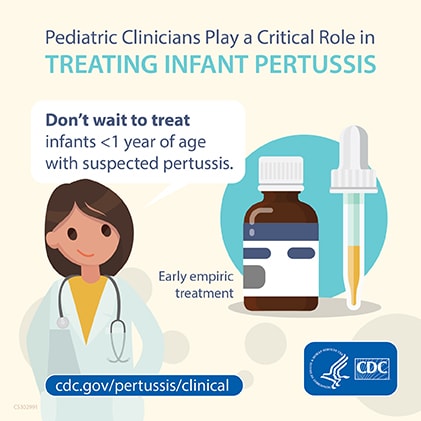Treatment
Ideally, treat pertussis during the first 1 to 2 weeks before coughing paroxysms occurs. Treatment is ineffective if started late in the course of illness.
Report cases of pertussis to the local public health department as soon as possible to assist with preventing additional cases.

Early empiric treatment is important for infants <1 year of age with suspected pertussis.
Early treatment of pertussis is most effective for reducing symptom severity. The earlier a person, especially an infant, starts treatment the better. If a person starts treatment during the first 1 to 2 weeks before coughing paroxysms occur, symptoms may be lessened. Antibiotics will not alter the course of the illness or prevent transmission if they are given later in the course of illness.
Clinicians should strongly consider treating prior to test results if any of the following are present:
- Clinical history is strongly suggestive of pertussis
- The person is at risk for severe or complicated disease (e.g., infants)
- The person has or will soon have routine contact with someone that is considered at high risk of serious disease (e.g., pregnant women)
A reasonable guideline is to treat
- Persons 1 year of age and older within 3 weeks of cough onset
- Infants younger than 1 year of age and pregnant women (especially if they are near term) within 6 weeks of cough onset
The recommended antimicrobial agents for treatment or chemoprophylaxis of pertussis are
- Azithromycin*
- Clarithromycin
- Erythromycin
Clinicians can also use Trimethoprim-sulfamethoxasole.
Clinicians should choose the antimicrobial after consideration of the
- Potential for adverse events and drug interactions
- Tolerability
- Ease of adherence to the regimen prescribed
- Cost
Macrolides erythromycin, clarithromycin, and azithromycin* are preferred for the treatment of pertussis in persons 1 month of age and older.
For persons 2 months of age and older, an alternative to macrolides is trimethoprim-sulfamethoxazole.
For infants younger than 1 month of age, use macrolides with caution as an association between orally administered erythromycin and azithromycin with infantile hypertrophic pyloric stenosis (IHPS) has been reported. However, azithromycin remains the drug of choice for treatment or prophylaxis of pertussis in very young infants because the risk of developing severe pertussis and life-threatening complications outweighs the potential risk of IHPS. Clinicians should monitor infants younger than 1 month of age who receive a macrolide for the development of IHPS and for other serious adverse events.
View photos of pertussis, including an infant getting treatment for pertussis in the hospital.
CDC supports targeting postexposure antibiotic use to persons at high risk of developing severe pertussis and to persons who will have close contact with those at high risk of developing severe pertussis. Learn more about use of PEP.
On March 12, 2013, the Food and Drug Administration (FDA) issued a warning that azithromycin can cause abnormal changes in the electrical activity of the heart that may lead to a potentially fatal irregular heart rhythm in some patients. Azithromycin remains one of the recommended drugs for treatment and chemoprophylaxis of pertussis, but consider using an alternative drug in those who have known cardiovascular disease, including:
- Patients with known prolongation of the QT interval, a history of torsades de pointes, congenital long QT syndrome, bradyarrhythmias, or uncompensated heart failure
- Patients on drugs known to prolong the QT interval
- Patients with ongoing proarrhythmic conditions such as uncorrected hypokalemia or hypomagnesemia, clinically significant bradycardia, and in patients receiving Class IA (quinidine, procainamide) or Class III (dofetilide, amiodarone, sotalol) antiarrhythmic agents.
Elderly patients and patients with cardiac disease may be more susceptible to the effects of arrhythmogenic drugs on the QT interval.